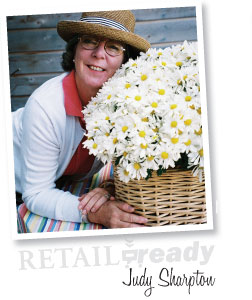10/29/2014
Success-Oriented Gardening
Judy Sharpton

In this column last November, I outlined a series of reasons for our industry to be thankful. Among those reasons, which remain just as valid in 2014, is the continued interest of modern consumers in live plants and fresh food. In an era of plastic-fantastic, when you have to touch the orchid in the hotel lobby to determine if it is silk or live, humans still want a living garden. That garden can range from a desktop succulent planter to a sweep of summer perennials to make Martha Stewart smile. Writers and chefs from Dan Barber of Stone Barns to Food Channel celebrities continue to drive the current interest in cooking. And, even though an heirloom tomato may be a little harder to grow than the average patio variety, gardeners who have nothing more than a sunny balcony continue to try.
For all of those blessings, we can continue to be thankful. This year, however, we have even more to be thankful for. For the first time in years, sales are up across the industry. The 2013 National Gardening Survey may not be the harbinger of a long-term trend, but it sure is good news for an industry hit hard by recession-related negatives. With an overall 18% rise in sales and a 21% rise in individual household spending on DIY gardening, the good news just keeps on coming. To add to the positives, food gardening seems to be driving an ongoing interest among the much-to-be-desired 18- to 34-year-old consumer.
With all this good news, experts from all over the industry are telling us we cannot continue to offer the consumer a 1990s store. A recent column written by Ian Baldwin puts it succinctly: “The word ‘gardening’ has an image that doesn’t even begin to describe so many of the positive aspect this activity offers—we probably need a new word.” Ron Vanderhoff of Roger’s Gardens reiterates this position when he says, “People still want ‘gardens,’ they just don’t want ‘gardening.’”
So, what to do? Kip Creel of Standpoint Research began preparing us for these realities many years ago. Kip told us the consumer wanted gardens as a product, not as a process. That research plays out in the recent words of many within the industry. Ron Hilgeman of White Oak Gardens says “ . . . we are seeing the greatest increase in the customer who just wants the patio to look good for the weekend.” Chris Cordrey of East Coast Garden Center says, “Our largest increasing category would definitely be container gardening. Grab-and-go container sales are the highest they have ever been.” These observations are anecdotal confirmation of Kip’s predictions.
I hear something more in these quotes. Both of these stores have invested in store renovation and branding over the past several years. You’ve seen White Oak featured in articles about professional merchandising techniques. East Coast Garden Center created a new container gardening department and then revamped their interior sales area to make checkout easier.
In his keynote speech at both IGC venues this past August, Corey Bordine challenged garden centers not to become bowling alleys: outdated and rundown facilities with smelly shoes and bad food.
With all this information urging our industry to offer a success-oriented garden product instead of a time-consuming gardening process, I still have people ask me for bench layouts. What we should be designing are project departments. Some stores have begun this process. Goebbert’s in Chicago has a container department that employs 12 people. Kootsier’s in Grand Rapids opened its Bloom Studio to great success. East Coast Garden Center reinvented the container gardening part of their business to encompass both retail and landscaping segments of their business. And more than 250 independent garden centers have installed the Proven Winners Store-Within-A-Store, most often directly adjacent to a container gardening work station, to capitalize on consumer brand awareness and in-store POP.
We can be success centers, not bowling alleys. But we’ll have to do more than just be thankful. We’ll have to create shopping environments that appeal to the consumer’s desire for a garden, instead of gardening.
GP
Judy Sharpton, LEED Green Associate and member of ARCSA, is a garden center design and renovation specialist with 35 years experience in advertising and promotion, and is the owner of Growing Places Marketing.